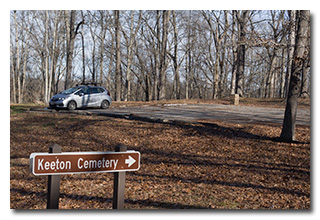
by William Eric McFadden
From the Lake Hope State Park website:
-
Lake Hope State Park offers a truly relaxing, yet rustic getaway from the high speed of modern life. The entire park lies within the Zaleski State Forest in the valley of Big Sandy Run. The park's heavily forested region is marked by steep gorges and narrow ridges with remnants of abandoned mining and iron-producing industries.
The park surrounds the lake and boasts a wooded family campground and a variety of cabins for families and gatherings of all sizes, including the roomy Laurel Lodge. No visit to the park is complete without a stop in the dining lodge for a hearty meal.
From the Zaleski State Forest website:
-
The 27,822-acre Zaleski State Forest is the second largest forest in Ohio's system of state forests.
Zaleski State Forest operates the only state-owned sawmill in Ohio. The mill produces rough sawn lumber for use by Ohio’s state forests and state parks as well as other government agencies.
Historic Moonville Tunnel is located within Zaleski State Forest on the Moonville Rail Trail right-of-way.
Pictures
Description
 On Tuesday, January 11, 2022, one member of the Southeast Ohio Radio Adventure Team
performed a successful impromptu two-fer activation of Lake Hope State Park and Zaleski State Forest in Ohio as part of the Parks on the Air (POTA; link)
program.
On Tuesday, January 11, 2022, one member of the Southeast Ohio Radio Adventure Team
performed a successful impromptu two-fer activation of Lake Hope State Park and Zaleski State Forest in Ohio as part of the Parks on the Air (POTA; link)
program.
Eric McFadden, WD8RIF, visited Keeton Cemetery within Lake Hope State Park on a cold but sunny afternoon to perform his two-fer activation of Lake Hope State Park and Zaleski State Forest. Eric was accompanied by the small dogs Theo and Mindy.
Eric arrived at Keeton Cemetery at about 1745 UTC, parked his car, walked the dogs, and quickly set up his 28½' wire vertical on his Jackite 31' telescoping fiberglass mast and drive-on mount, and set up his KX3 inside his car. Eric was on the air at 1800 UTC.
As at his previous visits to Keeton Cemetery, Eric found he had sufficiently-strong cell-signal to allow him to use the POTA Spots website (link) to spot himself and to look for possible park-to-park (P2P) QSOs.
Eric began operations by looking for P2P opportunities and quickly made three P2P QSOs on 20m. At 1801 UTC, Eric made a P2P QSO with K5SJC who was activating Caddo National Grasslands Wildlife Management Area (K-4370) in Texas. At 1803 UTC, Eric made a P2P QSO with WI2X who was activating Oleta River State Park (K-1908) in Florida. At 1804 UTC, Eric made a P2P QSO with KW5CW who was activating Sam Rayburn House State Historic Site (K-6601) in Texas.
Finding a frequency to run on 40m, Eric's first QSO there came at 1813 UTC with NT2A in New York. QSOs came quickly, with Eric's ninth QSO on 40m coming at 1822 UTC with NT3U. This run included QSOs with operators in New York, North Carolina, New Hampshire, Ohio, Pennsylvania, and Virginia.
Pausing to check for P2P opportunities, at 1824 UTC Eric made a P2P QSO with AB9CA who was activating Buenos Aires National Wildlife Refuge (K-0173) in Arizona.
Finding a frequency to run on 30m, Eric's first QSO there came at 1829 UTC with KN4ZMA in Virginia. QSOs came steadily, with Eric's fifth QSO on 30m coming at 1835 UTC with N4EX in North Carolina. This run included QSOs with operators in Virginia, South Carolina, Florida, Wisconsin, and North Carolina.
In all, Eric made eighteen QSOs, including four P2P QSOs, in about thirty-five minutes. All of Eric's QSOs were CW and were made at the 5-watt level.
Eric also submitted his log to the World Wide Flora and Fauna in Amateur Radio (WWFF; link) program for Lake Hope State Park, KFF-1968.
(return)